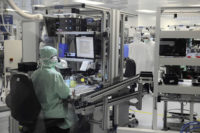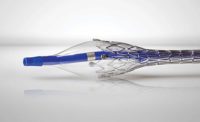Engineers have many options for joining identical or similar materials. To join, say, a steel part to another steel part, engineers can use screws, rivets, welds, adhesives, clinches or press-fits.
Engineers have fewer options for joining dissimilar materials, particularly if the parts are small. This is the challenge faced by medical device manufacturers. To join a stainless steel needle to a plastic hub, for example, there’s really only one option: adhesives.
Medical device manufacturers cannot use any adhesive, either. It must be biocompatible and be able to withstand sterilization processes. In addition, manufacturers must be able to dispense and cure it quickly to avoid causing bottlenecks in high-volume assembly lines.
Fortunately, adhesive suppliers have introduced several new formulations to help medical device manufacturers with tough bonding challenges.
Dymax Corp. has introduced 215-CTH-UR-SC, an LED-curable adhesive for assembling catheters made with Nylon 12 and polyether block amide (PEBA). The one-part adhesive has been formulated with the company’s Encompass chemistry, which helps manufacturers inspect bond lines and confirm that the adhesive has fully cured. The product’s blue color transitions to colorless when sufficient energy has been delivered to achieve full cure. The product also fluoresces bright red under low-intensity black light (365-nanometer wavelength), contrasting well on plastics that naturally fluoresce blue. This allows manufacturers to incorporate automated or manual inspection to ensure complete and accurate placement of the adhesive.
Typical applications include balloon-to-lumen bonding, hub-to-lumen bonding, marker bands and manifold bond joints. Recommended bondable substrates include Nylon 12, polycarbonate, polyethylene terephthalate (PET), PVC, ABS and PEBA.
Like all Dymax medical device adhesives, 215-CTH-UR-SC contains no nonreactive solvents and cures in seconds upon exposure to light. With a nominal viscosity of 20,000 centipoise, the adhesive comes in 3-milliliter and 10-milliliter syringes. It cures to a Shore hardness of D53, and elongation at break is 360 percent.
The adhesive meets ISO 10993 biocompatibility standards and complies fully with the RoHS Directives 2002/95/EC and 2003/11EC.
Henkel Corp. has developed two highly flexible instant adhesives, Loctite 4902 and 4903, that have excellent elongation properties and provide high-strength bonds in seconds. Both cyanoacrylates bond reliably to plastics, rubber, metals and other substrates and meet ISO 10993 biocompatibility requirements.
These one-part, low-viscosity adhesives flow easily onto any substrate and typically fixture to handling strength in 5 seconds or less. Loctite 4902 is the more flexible of the two, with an elongation of 155 percent and a modulus of 57,900 psi. Loctite 4903 offers 85 percent elongation and a modulus of 78,100 psi. In comparison, conventional cyanoacrylates elongate less than 2 percent and have moduli of greater than 200,000 psi.
The adhesives are formulated for use on close-fitting, flexible parts and easily bond dissimilar substrates from plastics to elastomers. Their flexibility rivals that of acrylic and urethane adhesives.
Both adhesives are available in either 20-gram or 1-pound packages. Loctite 770 or 7701 primers can be used to enhance bond strength on hard-to-bond substrates, such as polyethylene or polypropylene.
Bluestar Silicones has introduced two additions to its Silbione line of soft silicone adhesives for skin applications.
Silbione HC2 2022 is for wound care applications. This adhesive gel offers a high tack level for strong, yet gentle, adhesion to the skin. This medium-viscosity silicone gel is compatible with most coating processes and applicable on a range of substrates, including polyurethane films, perforated films and open-knit fabrics.
Silbione RT Gel 4642 is formulated for wearable devices, scar management and transdermal drug delivery applications. This high-tack silicone gel enables coaters to achieve improved adhesion levels to the skin at low coat-weights.


